Alfa Romeo 8C 2007 Owner handbook (in English)
Manufacturer: ALFA ROMEO, Model Year: 2007, Model line: 8C, Model: Alfa Romeo 8C 2007Pages: 223, PDF Size: 14.35 MB
Page 31 of 223
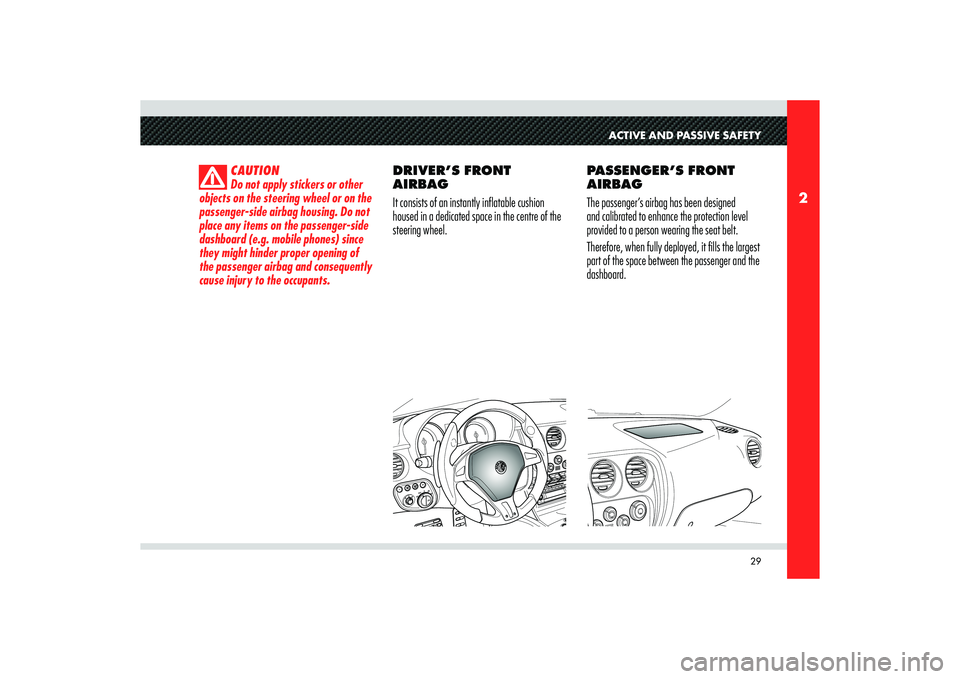
29
2
ACTIVE AND PASSIVE SAFETY
CAUTION
Do not apply stickers or other
objects on the steering wheel or on the
passenger-side airbag housing. Do not
place any items on the passenger-side
dashboard (e.g. mobile phones) since
they might hinder proper opening of
the passenger airbag and consequently
cause injury to the occupants.
DRIVER’S FRONT
AIRBAG
It consists of an instantly inflatable cushion
housed in a dedicated space in the centre of the
steering wheel.PASSENGER’S FRONT
AIRBAG
The passenger’s airbag has been designed
and calibrated to enhance the protection level
provided to a person wearing the seat belt.
Therefore, when fully deployed, it fills the largest
part of the space between the passenger and the
dashboard.
Page 32 of 223
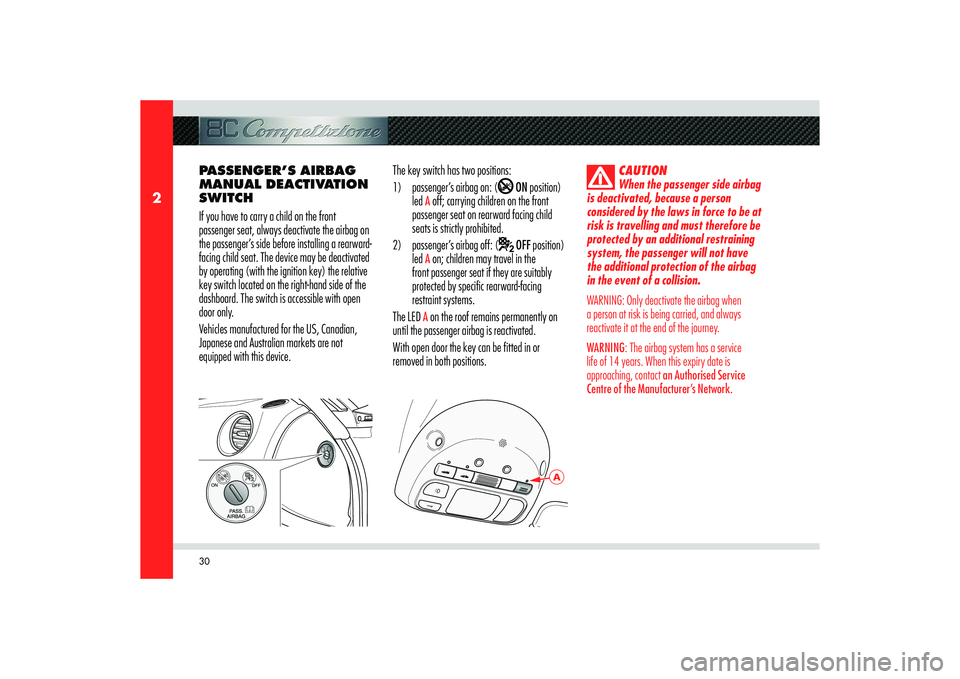
30
2
A
PASSENGER’S AIRBAG
MANUAL DEACTIVATION
SWITCH
If you have to carry a child on the front
passenger seat, always deactivate the airbag on
the passenger’s side before installing a rearward-
facing child seat. The device may be deactivated
by operating (with the ignition key) the relative
key switch located on the right-hand side of the
dashboard. The switch is accessible with open
door only.
Vehicles manufactured for the US, Canadian,
Japanese and Australian markets are not
equipped with this device.The key switch has two positions:
1) passenger’s airbag on: (
ON position)
led
A off; carrying children on the front
passenger seat on rearward facing child
seats is strictly prohibited.
2) passenger’s airbag off: (
OFF position)
led
A on; children may travel in the
front passenger seat if they are suitably
protected by specific rearward-facing
restraint systems.
The LED A on the roof remains permanently on
until the passenger airbag is reactivated.
With open door the key can be fitted in or
removed in both positions.
CAUTION
When the passenger side airbag
is deactivated, because a person
considered by the laws in force to be at
risk is travelling and must therefore be
protected by an additional restraining
system, the passenger will not have
the additional protection of the airbag
in the event of a collision.
WARNING: Only deactivate the airbag when
a person at risk is being carried, and always
reactivate it at the end of the journey.
WARNING: The airbag system has a service
life of 14 years. When this expiry date is
approaching, contact an Authorised Service
Centre of the Manufacturer’s Network.
Page 33 of 223
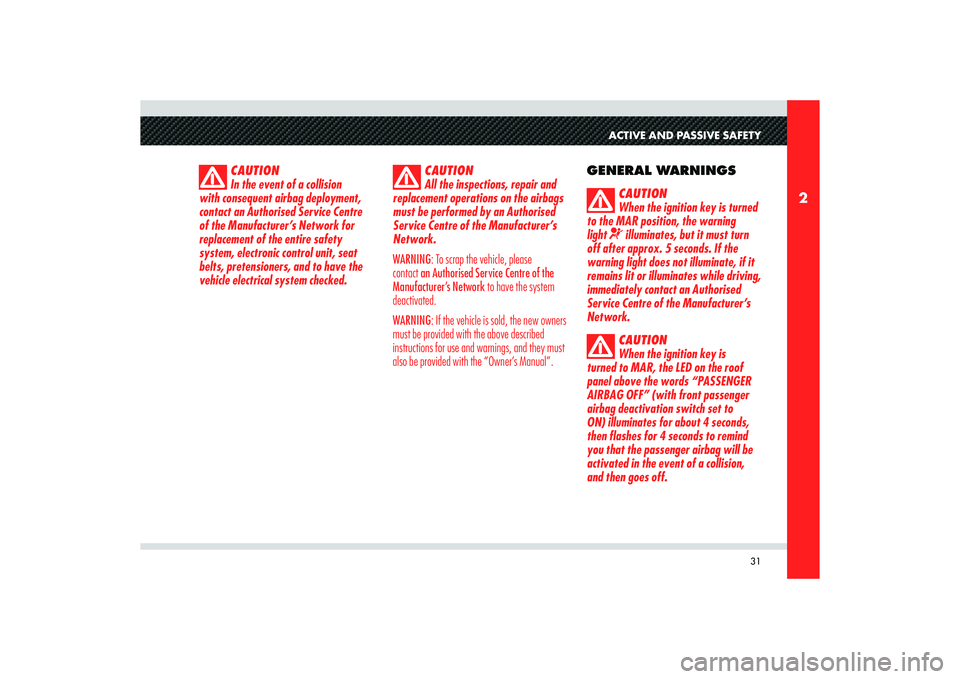
31
2
ACTIVE AND PASSIVE SAFETY
CAUTION
All the inspections, repair and
replacement operations on the airbags
must be performed by an Authorised
Service Centre of the Manufacturer’s
Network.
WARNING: To scrap the vehicle, please
contact an Authorised Service Centre of the
Manufacturer’s Network to have the system
deactivated.
WARNING: If the vehicle is sold, the new owners
must be provided with the above described
instructions for use and warnings, and they must
also be provided with the “Owner’s Manual”.
GENERAL WARNINGS
CAUTION
When the ignition key is turned
to the MAR position, the warning
light illuminates, but it must turn
off after approx. 5 seconds. If the
warning light does not illuminate, if it
remains lit or illuminates while driving,
immediately contact an Authorised
Service Centre of the Manufacturer’s
Network.
CAUTION
When the ignition key is
turned to MAR, the LED on the roof
panel above the words “PASSENGER
AIRBAG OFF” (with front passenger
airbag deactivation switch set to
ON) illuminates for about 4 seconds,
then flashes for 4 seconds to remind
you that the passenger airbag will be
activated in the event of a collision,
and then goes off.
CAUTION
In the event of a collision
with consequent airbag deployment,
contact an Authorised Service Centre
of the Manufacturer’s Network for
replacement of the entire safety
system, electronic control unit, seat
belts, pretensioners, and to have the
vehicle electrical system checked.
Page 34 of 223

32
2
CAUTION
Always drive keeping your
hands on the steering wheel so that, in
the case of activation, the airbag can
deploy without encountering obstacles
which may cause serious injuries. Do
not drive leaning forward, but keep
your seat back upright to support your
back.
CAUTION
To allow the front airbags to
deploy correctly and with optimal
efficiency, both the driver and the front
passenger must maintain a distance of
at least 25 cm from the steering wheel
and the dashboard.
CAUTION
Do not travel with objects in
your lap, in front of your chest or
holding a pipe, pencil or other object in
your mouth. In the event of a collision
with airbag deployment, these objects
may cause serious injuries.
CAUTION
Note that with the ignition
key inserted and turned to MAR,
even with the engine off, the airbags
may activate even if the vehicle is
stationary, if it is run into by another
vehicle. On the other hand, the airbags
will not activate in the event of a
collision with the vehicle stationary
and the key removed from the ignition
block: failure of the airbags to inflate
in these circumstances is not indicative
of system malfunction.CAUTION
If the vehicle has been subject
to theft or attempted theft, vandalism
or flooding, have the airbag system
checked at an Authorised Service
Centre of the Manufacturer’s Network.
CAUTION
If improper operations are
carried out on the electrical system,
the airbag could be activated, thereby
causing injuries to anyone in the
vicinity.
CAUTION
The airbags do not replace the
seat belts but provide supplementary
protection. Moreover, in the event of
head-on collisions at low speed, side
impacts, rear collisions or overturning,
the passengers are protected only by
the seat belts, which must always be
fastened.
Page 35 of 223
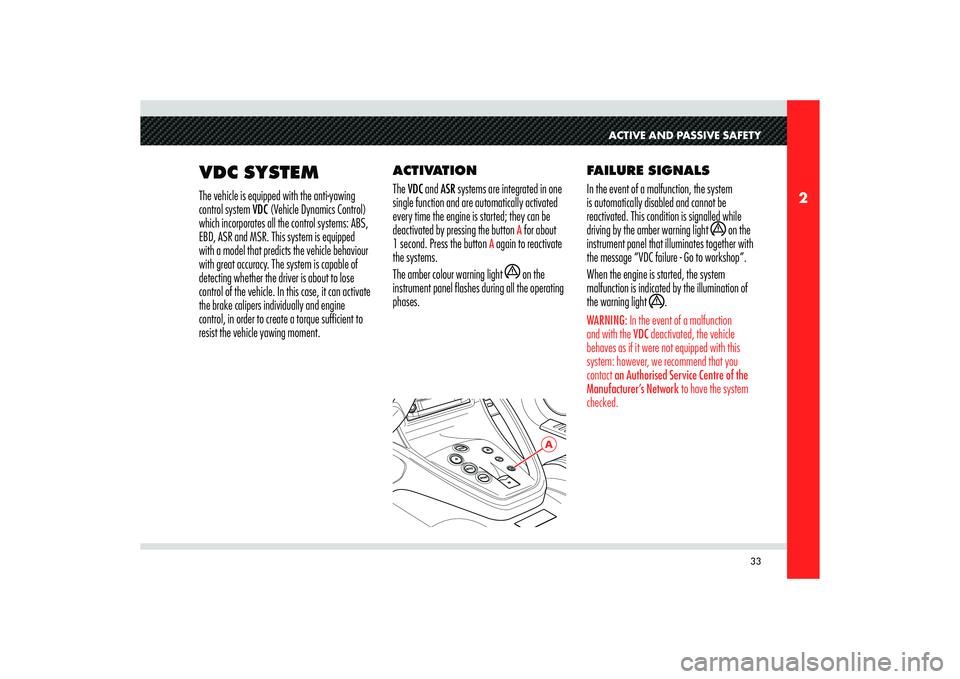
33
2
A
ACTIVE AND PASSIVE SAFETY
VDC SYSTEMThe vehicle is equipped with the anti-yawing
control system VDC (Vehicle Dynamics Control)
which incorporates all the control systems: ABS,
EBD, ASR and MSR. This system is equipped
with a model that predicts the vehicle behaviour
with great accuracy. The system is capable of
detecting whether the driver is about to lose
control of the vehicle. In this case, it can activate
the brake calipers individually and engine
control, in order to create a torque sufficient to
resist the vehicle yawing moment.ACTIVATION
The VDC and ASR systems are integrated in one
single function and are automatically activated
every time the engine is started; they can be
deactivated by pressing the button
A for about
1 second. Press the button
A again to reactivate
the systems.
The amber colour warning light
on the
instrument panel flashes during all the operating
phases.FAILURE SIGNALS
In the event of a malfunction, the system
is automatically disabled and cannot be
reactivated. This condition is signalled while
driving by the amber warning light on the
instrument panel that illuminates together with
the message “VDC failure - Go to workshop”.
When the engine is started, the system
malfunction is indicated by the illumination of
the warning light .
WARNING: In the event of a malfunction
and with the VDC deactivated, the vehicle
behaves as if it were not equipped with this
system: however, we recommend that you
contact an Authorised Service Centre of the
Manufacturer’s Network to have the system
checked.
Page 36 of 223
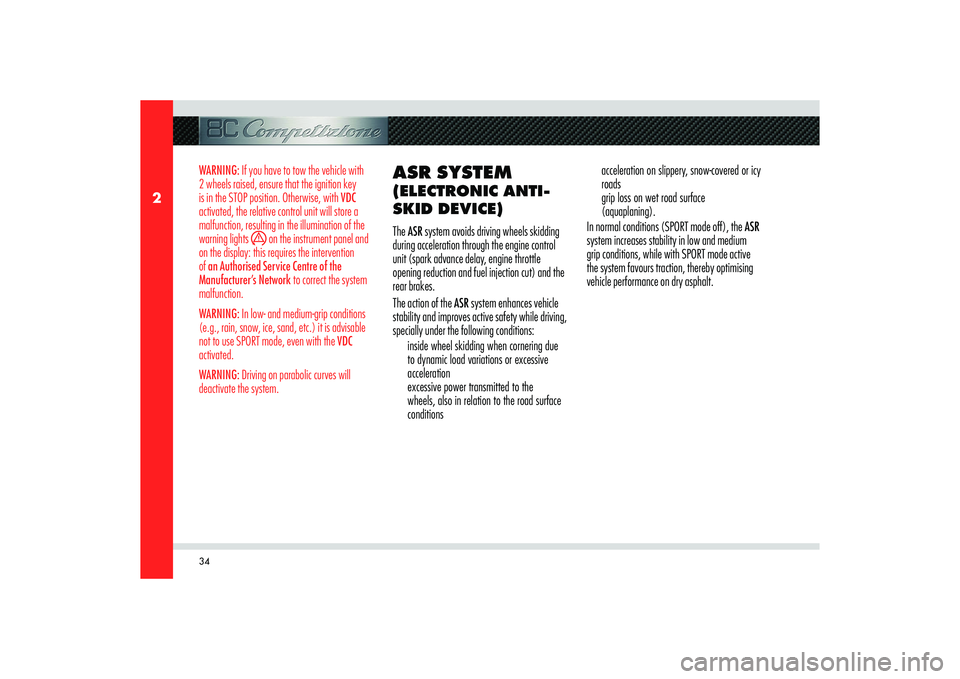
34
2
WARNING: If you have to tow the vehicle with
2 wheels raised, ensure that the ignition key
is in the STOP position. Otherwise, with VDC
activated, the relative control unit will store a
malfunction, resulting in the illumination of the
warning lights
on the instrument panel and
on the display: this requires the intervention
of an Authorised Service Centre of the
Manufacturer’s Network to correct the system
malfunction.
WARNING: In low- and medium-grip conditions
(e.g., rain, snow, ice, sand, etc.) it is advisable
not to use SPORT mode, even with the VDC
activated.
WARNING: Driving on parabolic curves will
deactivate the system.
ASR SYSTEM (ELECTRONIC ANTI-
SKID DEVICE)The ASR system avoids driving wheels skidding
during acceleration through the engine control
unit (spark advance delay, engine throttle
opening reduction and fuel injection cut) and the
rear brakes.
The action of the ASR system enhances vehicle
stability and improves active safety while driving,
specially under the following conditions:
inside wheel skidding when cornering due
to dynamic load variations or excessive
acceleration
excessive power transmitted to the
wheels, also in relation to the road surface
conditions acceleration on slippery, snow-covered or icy
roads
grip loss on wet road surface
(aquaplaning).
In normal conditions (SPORT mode off), the ASR
system increases stability in low and medium
grip conditions, while with SPORT mode active
the system favours traction, thereby optimising
vehicle performance on dry asphalt.
Page 37 of 223
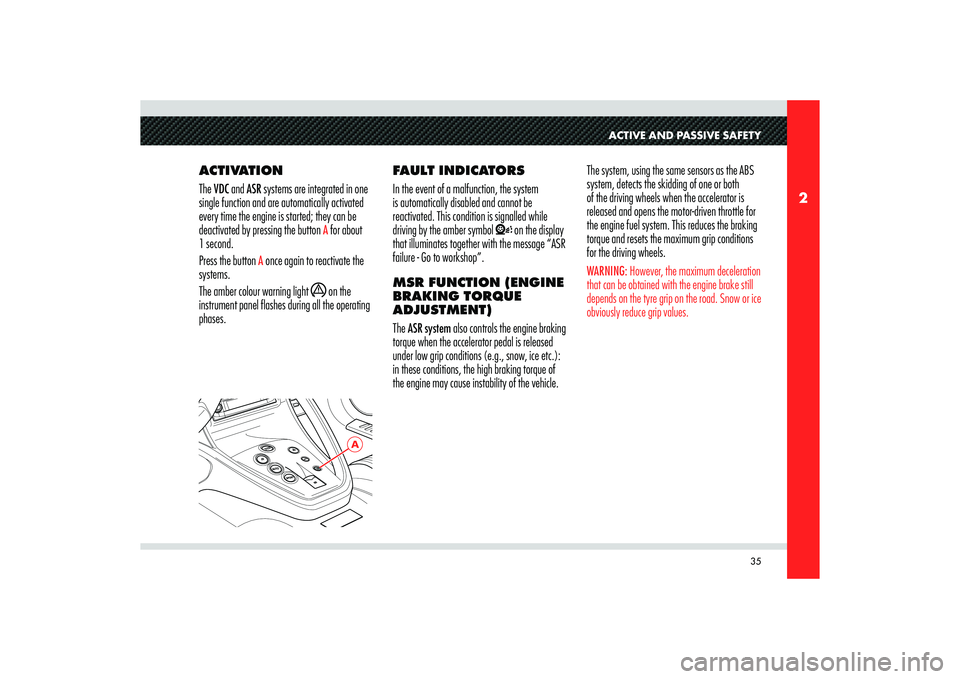
35
2
A
ACTIVE AND PASSIVE SAFETY
ACTIVATION
The VDC and ASR systems are integrated in one
single function and are automatically activated
every time the engine is started; they can be
deactivated by pressing the button
A for about
1 second.
Press the button
A once again to reactivate the
systems.
The amber colour warning light
on the
instrument panel flashes during all the operating
phases.FAULT INDICATORS
In the event of a malfunction, the system
is automatically disabled and cannot be
reactivated. This condition is signalled while
driving by the amber symbol
on the display
that illuminates together with the message “ASR
failure - Go to workshop”.
MSR FUNCTION (ENGINE
BRAKING TORQUE
ADJUSTMENT)
The ASR system also controls the engine braking
torque when the accelerator pedal is released
under low grip conditions (e.g., snow, ice etc.):
in these conditions, the high braking torque of
the engine may cause instability of the vehicle.The system, using the same sensors as the ABS
system, detects the skidding of one or both
of the driving wheels when the accelerator is
released and opens the motor-driven throttle for
the engine fuel system. This reduces the braking
torque and resets the maximum grip conditions
for the driving wheels.
WARNING: However, the maximum deceleration
that can be obtained with the engine brake still
depends on the tyre grip on the road. Snow or ice
obviously reduce grip values.
Page 38 of 223
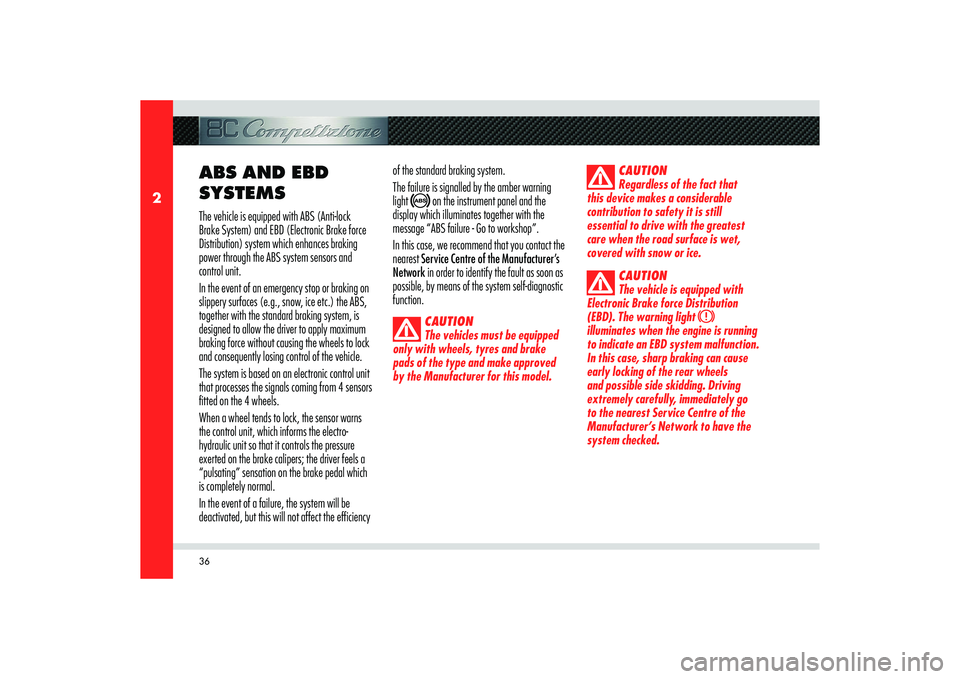
36
2
ABS AND EBD
SYSTEMSThe vehicle is equipped with ABS (Anti-lock
Brake System) and EBD (Electronic Brake force
Distribution) system which enhances braking
power through the ABS system sensors and
control unit.
In the event of an emergency stop or braking on
slippery surfaces (e.g., snow, ice etc.) the ABS,
together with the standard braking system, is
designed to allow the driver to apply maximum
braking force without causing the wheels to lock
and consequently losing control of the vehicle.
The system is based on an electronic control unit
that processes the signals coming from 4 sensors
fitted on the 4 wheels.
When a wheel tends to lock, the sensor warns
the control unit, which informs the electro-
hydraulic unit so that it controls the pressure
exerted on the brake calipers; the driver feels a
“pulsating” sensation on the brake pedal which
is completely normal.
In the event of a failure, the system will be
deactivated, but this will not affect the efficiency of the standard braking system.
The failure is signalled by the amber warning
light
on the instrument panel and the
display which illuminates together with the
message “ABS failure - Go to workshop”.
In this case, we recommend that you contact the
nearest Service Centre of the Manufacturer’s
Network in order to identify the fault as soon as
possible, by means of the system self-diagnostic
function.CAUTION
The vehicles must be equipped
only with wheels, tyres and brake
pads of the type and make approved
by the Manufacturer for this model.CAUTION
Regardless of the fact that
this device makes a considerable
contribution to safety it is still
essential to drive with the greatest
care when the road surface is wet,
covered with snow or ice.
CAUTION
The vehicle is equipped with
Electronic Brake force Distribution
(EBD). The warning light
illuminates when the engine is running
to indicate an EBD system malfunction.
In this case, sharp braking can cause
early locking of the rear wheels
and possible side skidding. Driving
extremely carefully, immediately go
to the nearest Service Centre of the
Manufacturer’s Network to have the
system checked.
Page 39 of 223
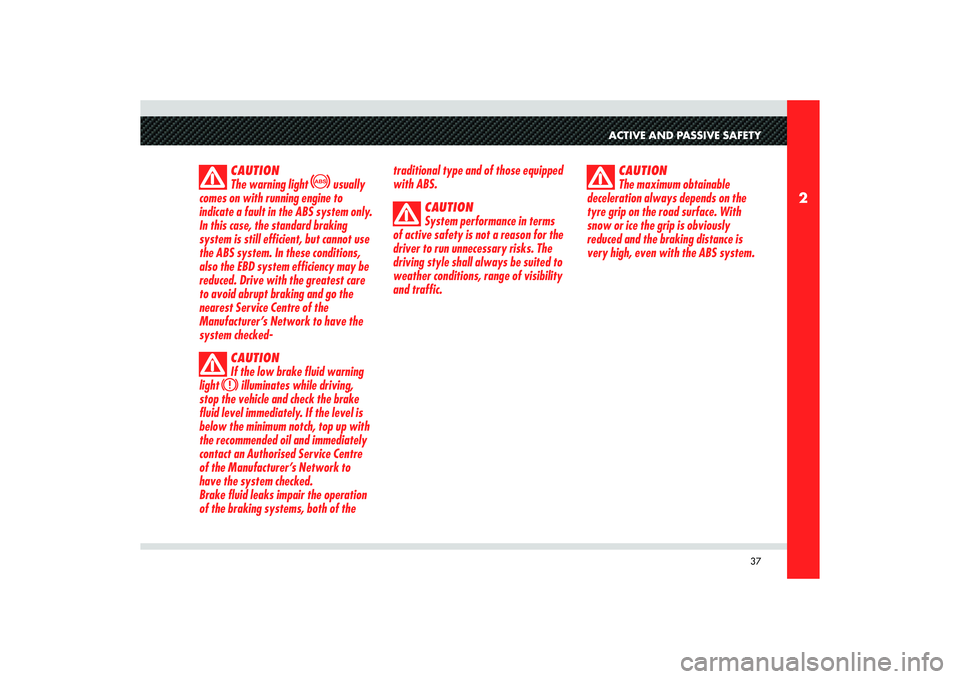
37
2
ACTIVE AND PASSIVE SAFETY
CAUTION
The warning light
usually
comes on with running engine to
indicate a fault in the ABS system only.
In this case, the standard braking
system is still efficient, but cannot use
the ABS system. In these conditions,
also the EBD system efficiency may be
reduced. Drive with the greatest care
to avoid abrupt braking and go the
nearest Service Centre of the
Manufacturer’s Network to have the
system checked-
CAUTION
If the low brake fluid warning
light
illuminates while driving,
stop the vehicle and check the brake
fluid level immediately. If the level is
below the minimum notch, top up with
the recommended oil and immediately
contact an Authorised Service Centre
of the Manufacturer’s Network to
have the system checked.
Brake fluid leaks impair the operation
of the braking systems, both of the
traditional type and of those equipped
with ABS.
CAUTION
System performance in terms
of active safety is not a reason for the
driver to run unnecessary risks. The
driving style shall always be suited to
weather conditions, range of visibility
and traffic.CAUTION
The maximum obtainable
deceleration always depends on the
tyre grip on the road surface. With
snow or ice the grip is obviously
reduced and the braking distance is
very high, even with the ABS system.
Page 40 of 223
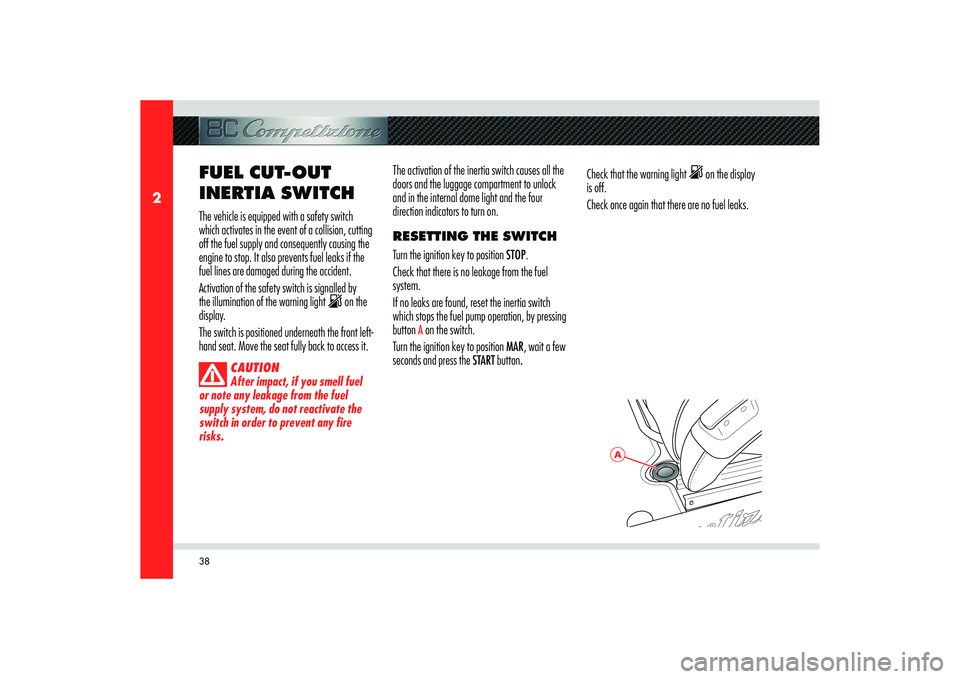
38
2
A
FUEL CUT-OUT
INERTIA SWITCHThe vehicle is equipped with a safety switch
which activates in the event of a collision, cutting
off the fuel supply and consequently causing the
engine to stop. It also prevents fuel leaks if the
fuel lines are damaged during the accident.
Activation of the safety switch is signalled by
the illumination of the warning light
on the
display.
The switch is positioned underneath the front left-
hand seat. Move the seat fully back to access it.
CAUTION
After impact, if you smell fuel
or note any leakage from the fuel
supply system, do not reactivate the
switch in order to prevent any fire
risks.
The activation of the inertia switch causes all the
doors and the luggage compartment to unlock
and in the internal dome light and the four
direction indicators to turn on.
RESETTING THE SWITCH
Turn the ignition key to position STOP.
Check that there is no leakage from the fuel
system.
If no leaks are found, reset the inertia switch
which stops the fuel pump operation, by pressing
button
A on the switch.
Turn the ignition key to position MAR, wait a few
seconds and press the START button.Check that the warning light
on the display
is off.
Check once again that there are no fuel leaks.